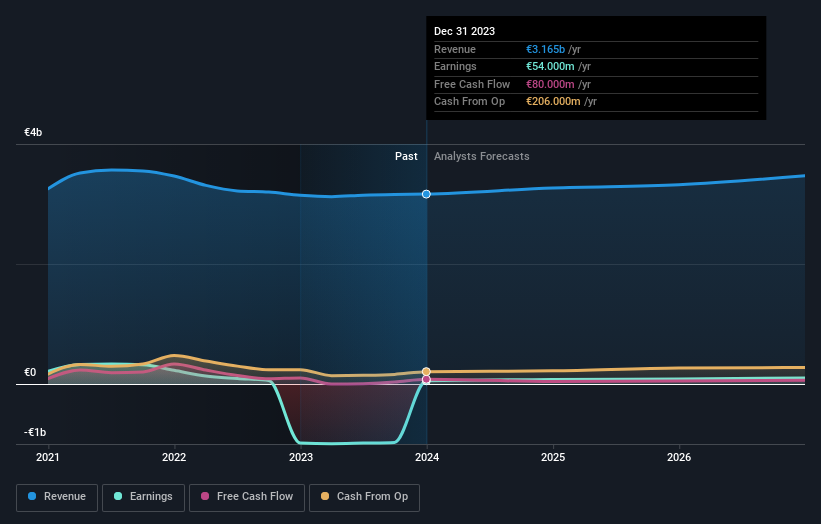PostNL N.V. Just Missed Earnings - But Analysts Have Updated Their Models
PostNL N.V. (AMS:PNL) shareholders are probably feeling a little disappointed, since its shares fell 7.2% to €1.25 in the week after its latest annual results. Revenues were in line with forecasts, at €3.2b, although statutory earnings per share came in 13% below what the analysts expected, at €0.11 per share. The analysts typically update their forecasts at each earnings report, and we can judge from their estimates whether their view of the company has changed or if there are any new concerns to be aware of. We thought readers would find it interesting to see the analysts latest (statutory) post-earnings forecasts for next year.
View our latest analysis for PostNL
Taking into account the latest results, the current consensus from PostNL's six analysts is for revenues of €3.27b in 2024. This would reflect a satisfactory 3.2% increase on its revenue over the past 12 months. Statutory earnings per share are predicted to jump 41% to €0.15. Yet prior to the latest earnings, the analysts had been anticipated revenues of €3.27b and earnings per share (EPS) of €0.16 in 2024. The analysts seem to have become a little more negative on the business after the latest results, given the minor downgrade to their earnings per share numbers for next year.
It might be a surprise to learn that the consensus price target was broadly unchanged at €1.39, with the analysts clearly implying that the forecast decline in earnings is not expected to have much of an impact on valuation. The consensus price target is just an average of individual analyst targets, so - it could be handy to see how wide the range of underlying estimates is. There are some variant perceptions on PostNL, with the most bullish analyst valuing it at €1.50 and the most bearish at €1.10 per share. With such a narrow range of valuations, the analysts apparently share similar views on what they think the business is worth.
Looking at the bigger picture now, one of the ways we can make sense of these forecasts is to see how they measure up against both past performance and industry growth estimates. The period to the end of 2024 brings more of the same, according to the analysts, with revenue forecast to display 3.2% growth on an annualised basis. That is in line with its 3.0% annual growth over the past five years. Compare this with the broader industry, which analyst estimates (in aggregate) suggest will see revenues grow 1.9% annually. So although PostNL is expected to maintain its revenue growth rate, it's definitely expected to grow faster than the wider industry.
The Bottom Line
The most important thing to take away is that the analysts downgraded their earnings per share estimates, showing that there has been a clear decline in sentiment following these results. Happily, there were no major changes to revenue forecasts, with the business still expected to grow faster than the wider industry. The consensus price target held steady at €1.39, with the latest estimates not enough to have an impact on their price targets.
Following on from that line of thought, we think that the long-term prospects of the business are much more relevant than next year's earnings. We have estimates - from multiple PostNL analysts - going out to 2026, and you can see them free on our platform here.
However, before you get too enthused, we've discovered 2 warning signs for PostNL that you should be aware of.
Have feedback on this article? Concerned about the content? Get in touch with us directly. Alternatively, email editorial-team (at) simplywallst.com.
This article by Simply Wall St is general in nature. We provide commentary based on historical data and analyst forecasts only using an unbiased methodology and our articles are not intended to be financial advice. It does not constitute a recommendation to buy or sell any stock, and does not take account of your objectives, or your financial situation. We aim to bring you long-term focused analysis driven by fundamental data. Note that our analysis may not factor in the latest price-sensitive company announcements or qualitative material. Simply Wall St has no position in any stocks mentioned.

